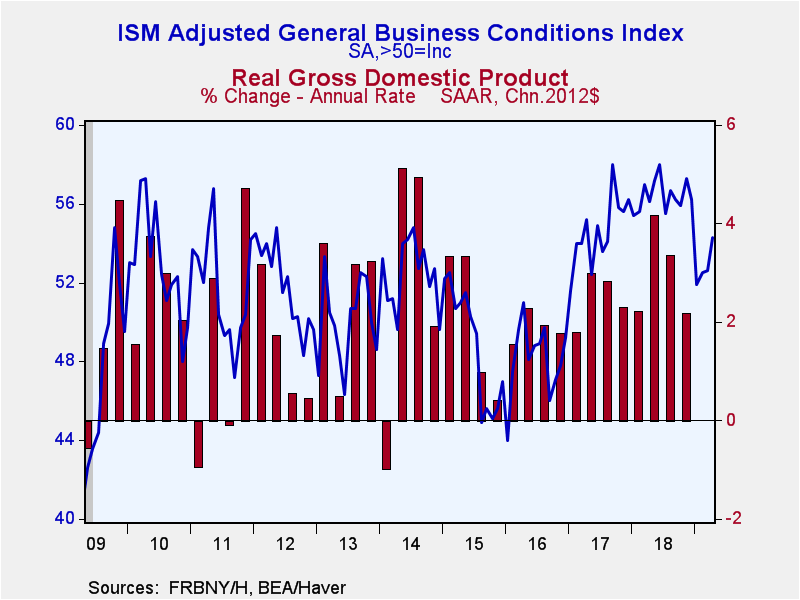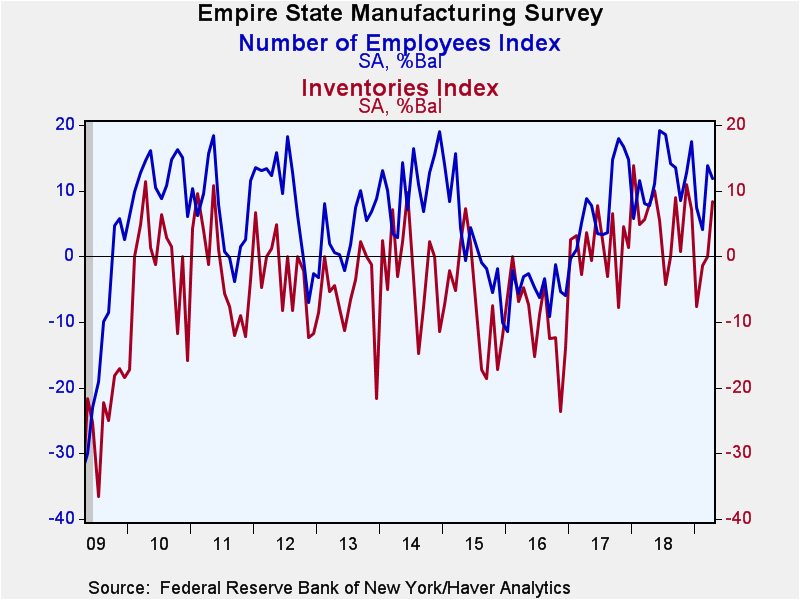 Global| Apr 15 2019
Global| Apr 15 2019Empire State Manufacturing Index Improves, but Prices Measure Weakens
by:Tom Moeller
|in:Economy in Brief
Summary
The Empire State Manufacturing Index of General Business Conditions rebounded to 10.1 during April and reversed the decline registered in March. Nevertheless, the latest level remained sharply below the reading of 17.9 twelve months [...]
The Empire State Manufacturing Index of General Business Conditions rebounded to 10.1 during April and reversed the decline registered in March. Nevertheless, the latest level remained sharply below the reading of 17.9 twelve months ago and was lower than the 2017 highs. The Action Economics Forecast Survey expected a reading of 8.0 for April. The Empire State data, reported by the Federal Reserve Bank of New York, reflect business conditions in New York, northern New Jersey and southern Connecticut.
Haver Analytics calculates a seasonally adjusted index that is comparable to the ISM series. The calculated figure rebounded to 54.3, the highest level since December. During the last ten years, the index has had a 50% correlation with the quarter-to-quarter change in real GDP.
Movement amongst the component series was mostly positive during April. The new orders index improved m/m but continued to trend sideways. The shipments reading ticked higher while the inventories index strengthened to a five-month high. To the downside, the unfilled orders measure declined and reversed its March gain.
The employment index eased and remained well below the 2018 highs. An improved 20% of respondents reported increased employment, while a higher eight percent showed a decrease. During the last ten years, there has been a 64% correlation between the employment index and the month-to-month change in factory sector payrolls. The employee workweek reading rebounded m/m to the highest level in three months, but remained down sharply y/y.
The decline in the prices paid index continued its weakening since the May 2018 peak. Twenty-seven percent of respondents indicated increased prices this month while six percent reported a decrease. The prices received index also declined sharply for a second month.
The series measuring expectations for business conditions in six months declined sharply to the lowest level in over three years. Weakness amongst the component series was broad-based, including a lower reading for capital spending intentions.
The Empire State figures are diffusion indexes, which are calculated by subtracting the percent of respondents reporting declines from those reporting gains. The data are available in Haver's SURVEYS database. The ISM-adjusted headline index dates back to 2001. The Action Economics Forecasts can be found in Haver's AS1REPNA database
| Empire State Manufacturing Survey | Apr | Mar | Feb | Apr'18 | 2018 | 2017 | 2016 |
|---|---|---|---|---|---|---|---|
| General Business Conditions (Diffusion Index, %, SA) | 10.1 | 3.7 | 8.8 | 17.9 | 19.8 | 16.1 | -2.6 |
| General Business Conditions Index (ISM Adjusted, >50=Increasing Activity, SA) | 54.3 | 52.6 | 52.5 | 56.1 | 56.4 | 54.6 | 48.1 |
| New Orders | 7.5 | 3.0 | 7.5 | 12.0 | 16.5 | 14.5 | -0.9 |
| Shipments | 8.6 | 7.7 | 10.4 | 17.1 | 20.4 | 15.9 | 1.9 |
| Unfilled Orders | -0.7 | 2.2 | -0.7 | 3.7 | 3.5 | 1.9 | -8.8 |
| Delivery Time | 7.0 | 1.4 | 5.0 | 15.6 | 9.1 | 6.1 | -4.8 |
| Inventories | 8.4 | 0.0 | -1.4 | 8.1 | 5.9 | 1.5 | -9.6 |
| Number of Employees | 11.9 | 13.8 | 4.1 | 7.8 | 12.4 | 8.1 | -5.1 |
| Average Employee Workweek | 4.3 | -3.4 | 2.5 | 12.8 | 7.8 | 4.6 | -5.1 |
| Prices Paid | 27.3 | 34.1 | 17.1 | 47.4 | 45.8 | 29.0 | 15.7 |
| Prices Received | 14.0 | 18.1 | 22.9 | 20.7 | 19.3 | 11.0 | 0.7 |
| Expectations 6 Months Ahead | 12.4 | 29.6 | 32.3 | 19.3 | 35.2 | 42.7 | 29.0 |
Tom Moeller
AuthorMore in Author Profile »Prior to joining Haver Analytics in 2000, Mr. Moeller worked as the Economist at Chancellor Capital Management from 1985 to 1999. There, he developed comprehensive economic forecasts and interpreted economic data for equity and fixed income portfolio managers. Also at Chancellor, Mr. Moeller worked as an equity analyst and was responsible for researching and rating companies in the economically sensitive automobile and housing industries for investment in Chancellor’s equity portfolio. Prior to joining Chancellor, Mr. Moeller was an Economist at Citibank from 1979 to 1984. He also analyzed pricing behavior in the metals industry for the Council on Wage and Price Stability in Washington, D.C. In 1999, Mr. Moeller received the award for most accurate forecast from the Forecasters' Club of New York. From 1990 to 1992 he was President of the New York Association for Business Economists. Mr. Moeller earned an M.B.A. in Finance from Fordham University, where he graduated in 1987. He holds a Bachelor of Arts in Economics from George Washington University.










